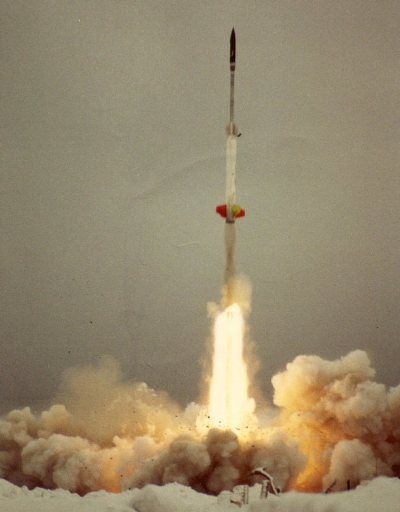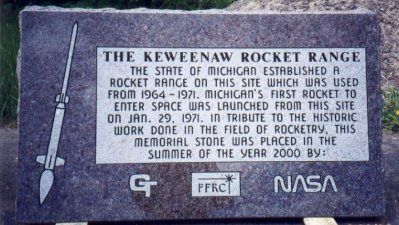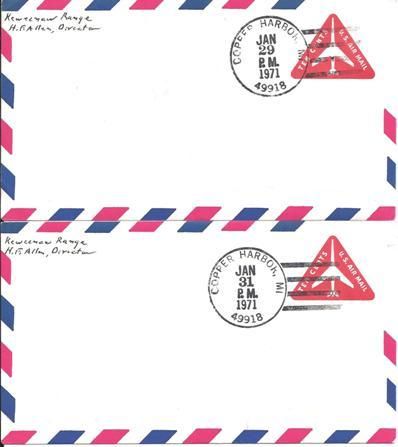Space Cover #275: Keweenaw Rocket RangeThe Keweenaw Rocket Range was an isolated launch pad located on the state of Michigan's Keweenaw Peninsula. It was used between 1964 and 1971 for launching rockets mainly for meteorological data collection under the direction of Dr. Harold Allen.
Glen Swanson interviewed Dr. Harold Allen and this is an excerpt from his history of the rocket range's last flights — 2 Nike-Apache launched in January 1971.
"In the fall of 1970," remembers Allen, "I got a call from Will Nelson, head of the department. He said that 'Goddard (NASA-Goddard Space Flight Center) wants to launch two Nike-Apaches from the Keweenaw Range. Do you think you can do it?' I said that it will take some doing but we'll give it a try."
NASA wanted to secure data on stratosphere warmings, an annual winter phenomenon in which warmings of the upper atmosphere spread southward from the Arctic. This warming effect pre-stages the change in seasons, but scientists were uncertain as to what caused the initial effect. Through these launches, NASA officials hoped to obtain data that would provide a reliable explanation as well as help in trouble-shooting various radio communications systems.
Each Nike-Apache would travel more than 100 miles above the ground and radio back its data. The first rocket to be launched, designated 14.167Gl, would carry a payload designed to measure the effects of magnetic storms caused by solar flares. The second rocket, 14.373GI, would carry a payload of five basic experiments designed to measure electron density, positive ion composition and distribution, energetic electron precipitation, solar X-rays and Lyman Alpha flux.
So began the Keweenaw Range's most ambitious project. Because Nike-Apache rockets were considerably larger and more powerful than anything launched before from the Range, a considerable amount of work had to be done to prepare the site.
The first thing that had to be done was to survey the area. "We started in October," recalls Allen. "They wanted an area big enough for their vans plus an enclosed heated building for rocket assembly and a rocket launcher." NASA would furnish the rockets, launcher and various support personnel. "We had to furnish everything else."
Land had to be cleared and roads had to be rebuilt to accommodate the heavy equipment vans. Concrete was poured for the launch pad and buildings and five one-hundred-foot-tall poles had to be secured for the antennas. "We selected five good straight white pine trees, cut them down and saved them for the antennas said Allen, "and that was the easy part. You see there is very little top soil in that region so we had to blast holes in the rocks using dynamite in order to put these things in." Building contracts were sent and arrangements had to be made to assure clear air space and that no ships would be in the area during the time of launch. "We were busy people," said Allen, "in the face of an oncoming north country winter."
The firings of the two Nike-Apaches were supposed to take place in the middle of December, but some of the equipment from Goddard did not show until later that month. The instrumentation van, the heaviest and most delicate piece of equipment to arrive was so heavy that they had to use a bull-dozer to help it up the hilly roads that led to the site. "The community was very helpful during that time. Every time we fell into a hole and had troubles, there was somebody in the area that could help us out."
By the end of December, they were ready for launch but the payload van did not arrive until the first of January. By then, all hell had broken loose.
"Right after they got here we had the damnedest blizzard you ever saw," said Allen. "We got all set and read to go and it snowed for 19 straight days without stopping. Ninety-four inches of snow fell that month, a new record for the region. It closed everything," said Allen. "We had to get the county plough to come out and plough the road out to the launch site. The county road commissioner himself came out with the plough to make sure that they did a good job for us. He charged us only $10 for plowing 10 miles of highway."
"This storm was way beyond any limits that they allowed us to fire rockets," said Allen. "We were on the wire with Wallops Island and with Goddard Space Flight Center all the time. We had orders not to fire the rocket under those conditions."
Because these two rockets were more powerful and had a greater range than anything launched before from the site, there was always the concern as to what degree the winds would effect their trajectories. "The one disadvantage at the Keweenaw site was that we could not shoot toward Marquette," remembers Dempsey B. Bruton Jr., Field Operations Manager at Wallops Island. Bruton worked at the Keweenaw during the time of the Nike- Apache flights. "You also had the Canadian border running down through the centre of Lake Superior. To avoid any international incident, we had to keep the impact inside the lake but not in Canadian territory." At that time, this looked to be quite a challenge.
After waiting nearly the entire month for weather conditions to improve, Goddard called and said, "if you don't fire it by the 29th, pack the rockets up and send them back to Wallops," recalled Allen. On 29 January conditions were marginal but they proved to be good enough for a launch. "We got one of the Nikes off," recalled Allen," and they got the data back and everything was first rate."

The next day, conditions worsened and it looked as though they would not be able to launch the second rocket. "The weather almost killed us," said Allen. "I was again on the phone with Goddard and they told me that come the next day, if we don't get it off the rocket goes back to Wallops." "Everybody was pulling to get this rocket off," remembers Burton. "And the wind was howling and the snow was flying but it was steady."
To fire a rocket you select a place where the thing is going to hit - your target point. Under a no-wind condition you can aim for that target with a rather small circle of error. But if there is a wind, you normally have problems. If there is a lateral wind, it will have a tendency to cause the rocket to drift, increasing your margin of error. If the wind blows on the rocket during the time it is firing (thrusting), it will blow across the fins used for stabilising the rocket (if it is a lateral wind) causing the rocket to tilt. Because these effects on the rocket can occur at different times during flight, it is important to know the effect of the wind at every altitude in order to try to compensate.
Those that calculate the effect of the winds that determine the target and launcher settings are called "wind weighters" because they calculate the effects or "weight" of the wind on the rocket. "We wind weighed the thing," explained Bruton. "We set off high altitude balloons and took anemometer readings to try and get the data as good as we could." The wind-weighters made calculations all that day and found that the conditions stayed steady.
"The winds were blowing like mad," said Bruton, "but they stayed constant all the way up. So these guys made their launchers settings and they were wild, they were big, but they were always nearly the same.' Allen had fired hundreds of rockets from Wallops Island, Virginia and had confidence in the crew at Keweenaw. "Goddard was concerned, and rightly so, that the rocket might land smack in the middle of the city of Marquette" said Allen. "So I asked to speak with the Range Director from Wallops." Allen talked with the Director reassuring him that they could launch the rocket on target. It began to get late in the day and darkness began to fall. "Finally, he said 'OK let's do it."
"So we put the phone down and went away and fired the damn rocket," said Allen. On 31 January, the second Nike- Apache Launched beautifully and landed within ten miles of the impact point. When they phoned Goddard to explain what they had done, they were furious. "They flew off the handle," recalls Allen. "They were going to shoot everybody." After getting word back from data recovery that all the data was great and that everything was fine, they cooled down. They said, "I guess it was all right," recalls Allen, "but don't ever do it again."
They never did do it again. The flights of 1971 were the last for the Keweenaw Range.

A stone was dedicated on October 15, 2000 in memory of the rocket launch site and currently resides at the Keweenaw Rocket Range site.
Covers can be found for the launches in January 1971 cancelled from the closest town of Copper Harbor, MI. The ones pictured above have a corner card from Dr. Allen.














